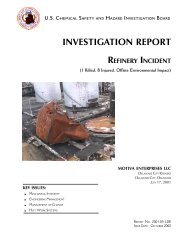CTA Report, Draft 1, ISP Review - US Chemical Safety and Hazard ...
CTA Report, Draft 1, ISP Review - US Chemical Safety and Hazard ...
CTA Report, Draft 1, ISP Review - US Chemical Safety and Hazard ...
You also want an ePaper? Increase the reach of your titles
YUMPU automatically turns print PDFs into web optimized ePapers that Google loves.
in the HazCom St<strong>and</strong>ard as “any potential occurrence such as, but not limited to, equipment failure,<br />
rupture of containers, or failure of control equipment which could result in an uncontrolled release of a<br />
hazardous chemical into the workplace.”<br />
CSB determined that the Borden <strong>Chemical</strong> phenolic resin MSDSs did not provide adequate warning of<br />
the explosion hazard. The MSDSs state that the resin is a combustible dust; however, they only reference<br />
NFPA 654, rather than listing specific safety warnings. Also, the information in different sections of the<br />
MSDSs was incomplete <strong>and</strong> inconsistent, <strong>and</strong> <strong>CTA</strong> personnel did not have a copy of NFPA 654.<br />
8.2.1 Comparison of Phenolic Resin MSDSs<br />
MSDSs were Borden <strong>Chemical</strong>’s primary means of communicating the hazards of phenolic resins to<br />
<strong>CTA</strong>. The two MSDSs for phenolic resin contained identical information with respect to fire <strong>and</strong><br />
explosion hazards. The most recent revision of the MSDS for the black phenolic resin, Borden <strong>Chemical</strong><br />
Durite SD-52SS, was dated January 31, 2003. The most recent revision of the MSDS for the natural<br />
(without carbon black) resin, Borden <strong>Chemical</strong> Durite SD-110A, was dated September 10, 2002.<br />
Borden <strong>Chemical</strong> personnel responsible for preparing MSDSs stated they followed the OSHA HazCom<br />
St<strong>and</strong>ard as well as American National St<strong>and</strong>ards Institute (ANSI) Z400.1, American National St<strong>and</strong>ard<br />
for <strong>Hazard</strong>ous Industrial <strong>Chemical</strong>s, Material <strong>Safety</strong> Data Sheets Preparation. Section 5.1 of ANSI<br />
Z400.1 states that qualitative flammable properties <strong>and</strong> reactivity hazards that enhance the fire <strong>and</strong><br />
explosion potential of a chemical should be stated in the firefighting measures section of the MSDS. The<br />
st<strong>and</strong>ard lists several examples of language that can be used on an MSDS; the first example listed is:<br />
“Powdered material may form explosive dust-air mixture.”<br />
Borden <strong>Chemical</strong> was aware that phenolic resins could produce dust explosions. In 1988, the predecessor<br />
of FM Global—Factory Mutual—provided results of explosibility tests conducted on Borden <strong>Chemical</strong><br />
Durite AD-6514 phenolic resin powder. (This particular powder was not used at <strong>CTA</strong>.) The tests showed<br />
62









